Marketing Data Insights: Quantitative and Qualitative Research
VerifiedAdded on 2023/06/10
|10
|2208
|169
Report
AI Summary
This report delves into the significance of quantitative and qualitative research within marketing research and data analysis. It explores the application of correlation and regression analyses, providing practical examples to illustrate their utility in organizational contexts. The report further defines time series analysis and its role in forecasting and decision-making. It highlights the importance of data collection methods and emphasizes the use of data-driven insights for informed business decisions. The report also covers the importance of discussion guides in qualitative research and their impact. The report concludes by summarizing the key takeaways and emphasizing the value of data analysis in the business context.
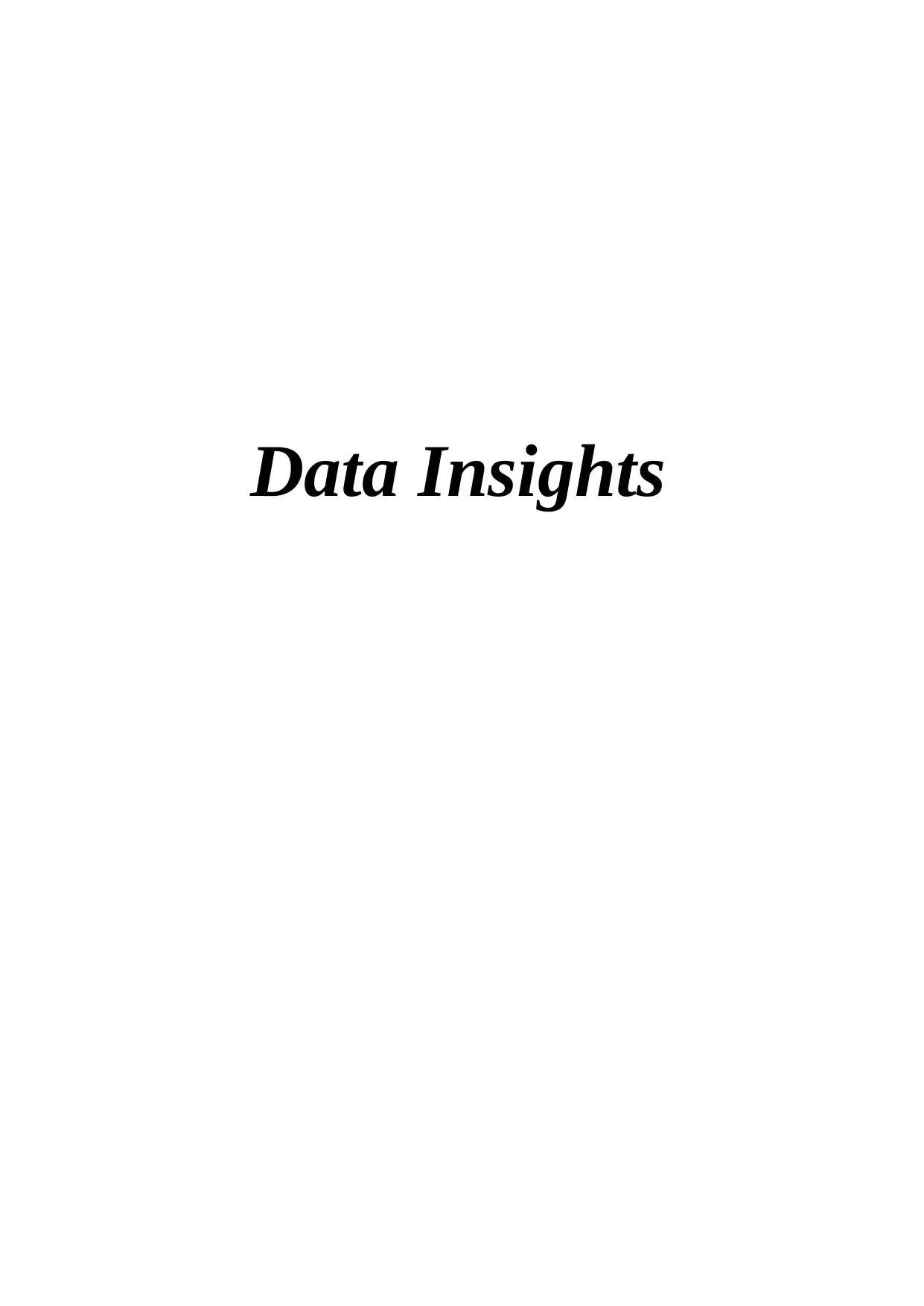
Data Insights
Paraphrase This Document
Need a fresh take? Get an instant paraphrase of this document with our AI Paraphraser
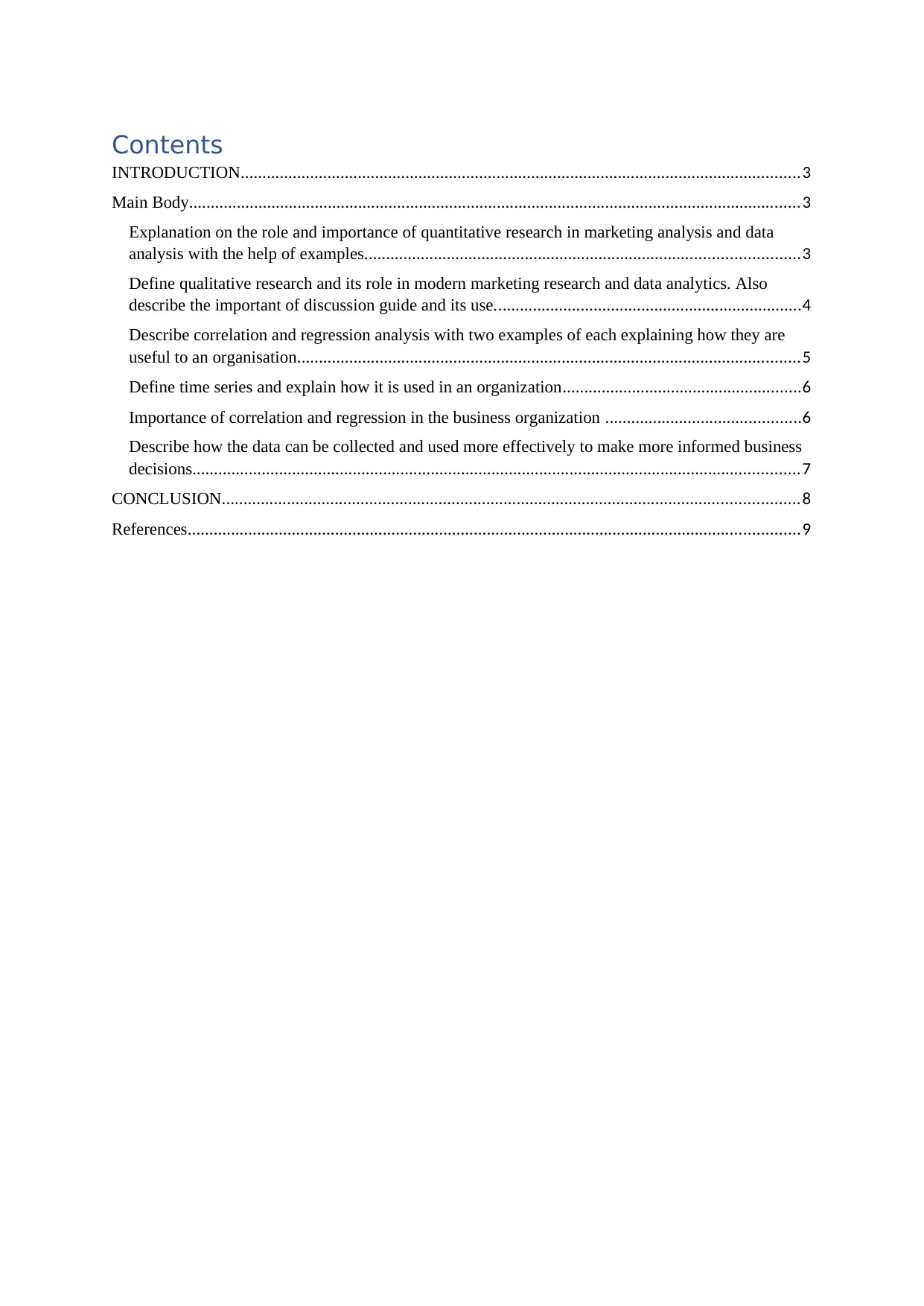
Contents
INTRODUCTION.................................................................................................................................3
Main Body.............................................................................................................................................3
Explanation on the role and importance of quantitative research in marketing analysis and data
analysis with the help of examples....................................................................................................3
Define qualitative research and its role in modern marketing research and data analytics. Also
describe the important of discussion guide and its use.......................................................................4
Describe correlation and regression analysis with two examples of each explaining how they are
useful to an organisation....................................................................................................................5
Define time series and explain how it is used in an organization.......................................................6
Importance of correlation and regression in the business organization .............................................6
Describe how the data can be collected and used more effectively to make more informed business
decisions............................................................................................................................................7
CONCLUSION.....................................................................................................................................8
References.............................................................................................................................................9
INTRODUCTION.................................................................................................................................3
Main Body.............................................................................................................................................3
Explanation on the role and importance of quantitative research in marketing analysis and data
analysis with the help of examples....................................................................................................3
Define qualitative research and its role in modern marketing research and data analytics. Also
describe the important of discussion guide and its use.......................................................................4
Describe correlation and regression analysis with two examples of each explaining how they are
useful to an organisation....................................................................................................................5
Define time series and explain how it is used in an organization.......................................................6
Importance of correlation and regression in the business organization .............................................6
Describe how the data can be collected and used more effectively to make more informed business
decisions............................................................................................................................................7
CONCLUSION.....................................................................................................................................8
References.............................................................................................................................................9
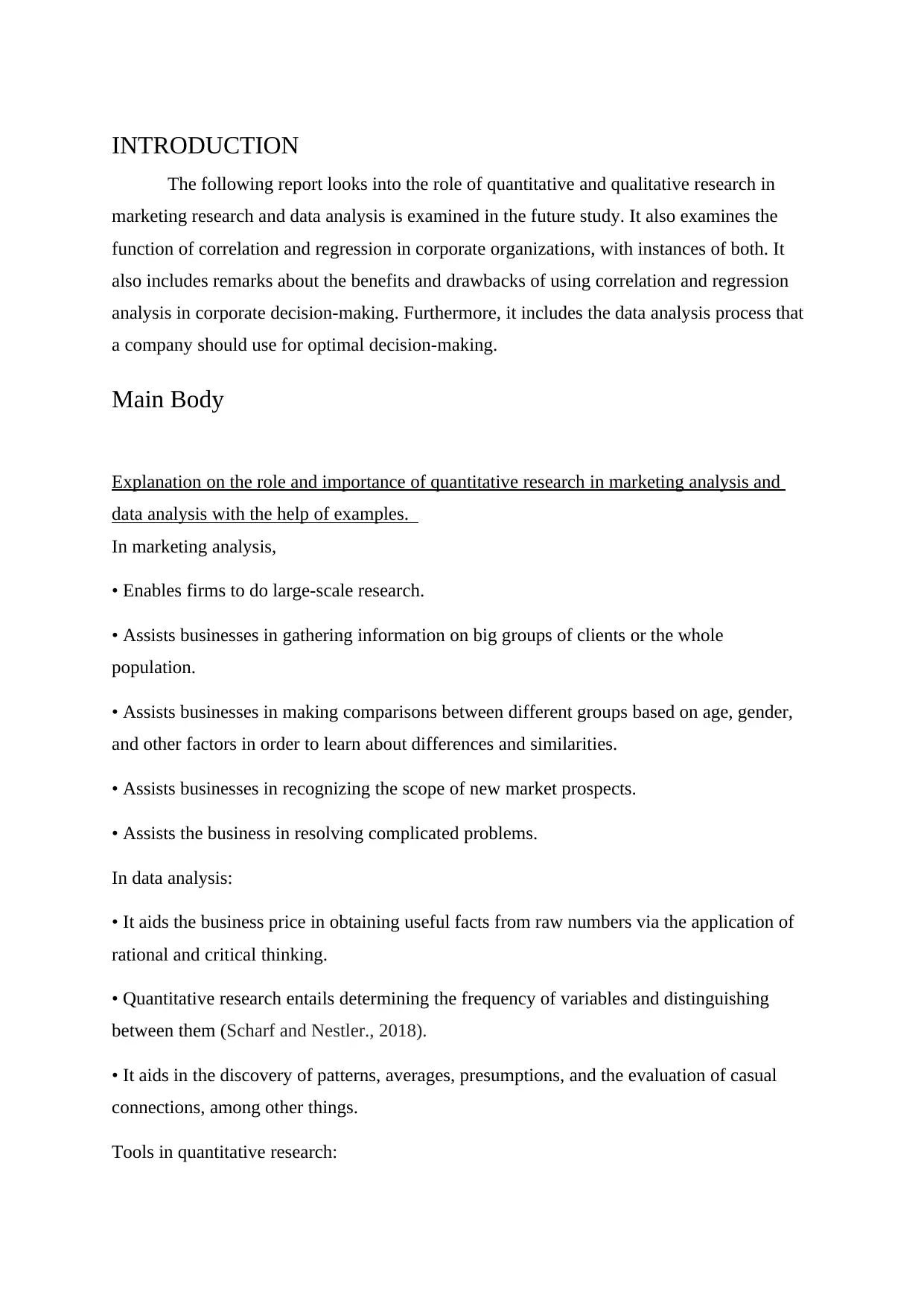
INTRODUCTION
The following report looks into the role of quantitative and qualitative research in
marketing research and data analysis is examined in the future study. It also examines the
function of correlation and regression in corporate organizations, with instances of both. It
also includes remarks about the benefits and drawbacks of using correlation and regression
analysis in corporate decision-making. Furthermore, it includes the data analysis process that
a company should use for optimal decision-making.
Main Body
Explanation on the role and importance of quantitative research in marketing analysis and
data analysis with the help of examples.
In marketing analysis,
• Enables firms to do large-scale research.
• Assists businesses in gathering information on big groups of clients or the whole
population.
• Assists businesses in making comparisons between different groups based on age, gender,
and other factors in order to learn about differences and similarities.
• Assists businesses in recognizing the scope of new market prospects.
• Assists the business in resolving complicated problems.
In data analysis:
• It aids the business price in obtaining useful facts from raw numbers via the application of
rational and critical thinking.
• Quantitative research entails determining the frequency of variables and distinguishing
between them (Scharf and Nestler., 2018).
• It aids in the discovery of patterns, averages, presumptions, and the evaluation of casual
connections, among other things.
Tools in quantitative research:
The following report looks into the role of quantitative and qualitative research in
marketing research and data analysis is examined in the future study. It also examines the
function of correlation and regression in corporate organizations, with instances of both. It
also includes remarks about the benefits and drawbacks of using correlation and regression
analysis in corporate decision-making. Furthermore, it includes the data analysis process that
a company should use for optimal decision-making.
Main Body
Explanation on the role and importance of quantitative research in marketing analysis and
data analysis with the help of examples.
In marketing analysis,
• Enables firms to do large-scale research.
• Assists businesses in gathering information on big groups of clients or the whole
population.
• Assists businesses in making comparisons between different groups based on age, gender,
and other factors in order to learn about differences and similarities.
• Assists businesses in recognizing the scope of new market prospects.
• Assists the business in resolving complicated problems.
In data analysis:
• It aids the business price in obtaining useful facts from raw numbers via the application of
rational and critical thinking.
• Quantitative research entails determining the frequency of variables and distinguishing
between them (Scharf and Nestler., 2018).
• It aids in the discovery of patterns, averages, presumptions, and the evaluation of casual
connections, among other things.
Tools in quantitative research:
⊘ This is a preview!⊘
Do you want full access?
Subscribe today to unlock all pages.

Trusted by 1+ million students worldwide

• Probability Sampling: This refers to the possibility of include every member of the targeted
population in the sample. For example, if there are 100 persons in the population, each person
has a one-in-a-hundred chance of being chosen for the sample.
• Interview: This is the method for gathering data. Telephonic, face-to-face, and computer-
assisted personal interviewing are all options. For example, data may be acquired in a
quantitative manner from interviewing a candidate, such as how frequently a person texts
while driving.
• Surveys/questionnaires: Using an online software system to create surveys is a terrific way
to gather data in an online format. It aids in the simplicity and understanding of the
customer's attitude. It may be done in two ways: with a postal questionnaire or through a
web-based questionnaire. For instance, quantitative responses can be obtained from yes/no,
rating scales, and so on.
• Observations: It is the most straightforward way of data collection. It is carried out by
researchers by systematic observation, such as counting the number of persons present at a
specified location and time. Age, weight, height, length, population, size, and other numerical
quantities are examples.
Relevance of questionnaire design in the qualitative research.
• Usability: The questionnaire assists the firm in identifying and targeting clients, as well as
allowing the researchers to manage strategically. It also aids in the management of questions
and formats by gathering enormous amounts of data.
• Cost-effectiveness: Business owners may quickly post surveys on their website and receive
responses from customers. There are no surveyors working in this project. As a result, there is
no additional price.
• Comparability: The questionnaire may be compared year after year, allowing the
organization to gain valuable insights and correct and minimize mistakes.
• Simple analysis: Questionnaires have a designed statistical tool for easy interpretation.
Define qualitative research and its role in modern marketing research and data analytics. Also
describe the important of discussion guide and its use.
Qualitative research is a form of investigation that examines facts provided in real
situations through language and behavior. It's the method that conveys expressive
population in the sample. For example, if there are 100 persons in the population, each person
has a one-in-a-hundred chance of being chosen for the sample.
• Interview: This is the method for gathering data. Telephonic, face-to-face, and computer-
assisted personal interviewing are all options. For example, data may be acquired in a
quantitative manner from interviewing a candidate, such as how frequently a person texts
while driving.
• Surveys/questionnaires: Using an online software system to create surveys is a terrific way
to gather data in an online format. It aids in the simplicity and understanding of the
customer's attitude. It may be done in two ways: with a postal questionnaire or through a
web-based questionnaire. For instance, quantitative responses can be obtained from yes/no,
rating scales, and so on.
• Observations: It is the most straightforward way of data collection. It is carried out by
researchers by systematic observation, such as counting the number of persons present at a
specified location and time. Age, weight, height, length, population, size, and other numerical
quantities are examples.
Relevance of questionnaire design in the qualitative research.
• Usability: The questionnaire assists the firm in identifying and targeting clients, as well as
allowing the researchers to manage strategically. It also aids in the management of questions
and formats by gathering enormous amounts of data.
• Cost-effectiveness: Business owners may quickly post surveys on their website and receive
responses from customers. There are no surveyors working in this project. As a result, there is
no additional price.
• Comparability: The questionnaire may be compared year after year, allowing the
organization to gain valuable insights and correct and minimize mistakes.
• Simple analysis: Questionnaires have a designed statistical tool for easy interpretation.
Define qualitative research and its role in modern marketing research and data analytics. Also
describe the important of discussion guide and its use.
Qualitative research is a form of investigation that examines facts provided in real
situations through language and behavior. It's the method that conveys expressive
Paraphrase This Document
Need a fresh take? Get an instant paraphrase of this document with our AI Paraphraser
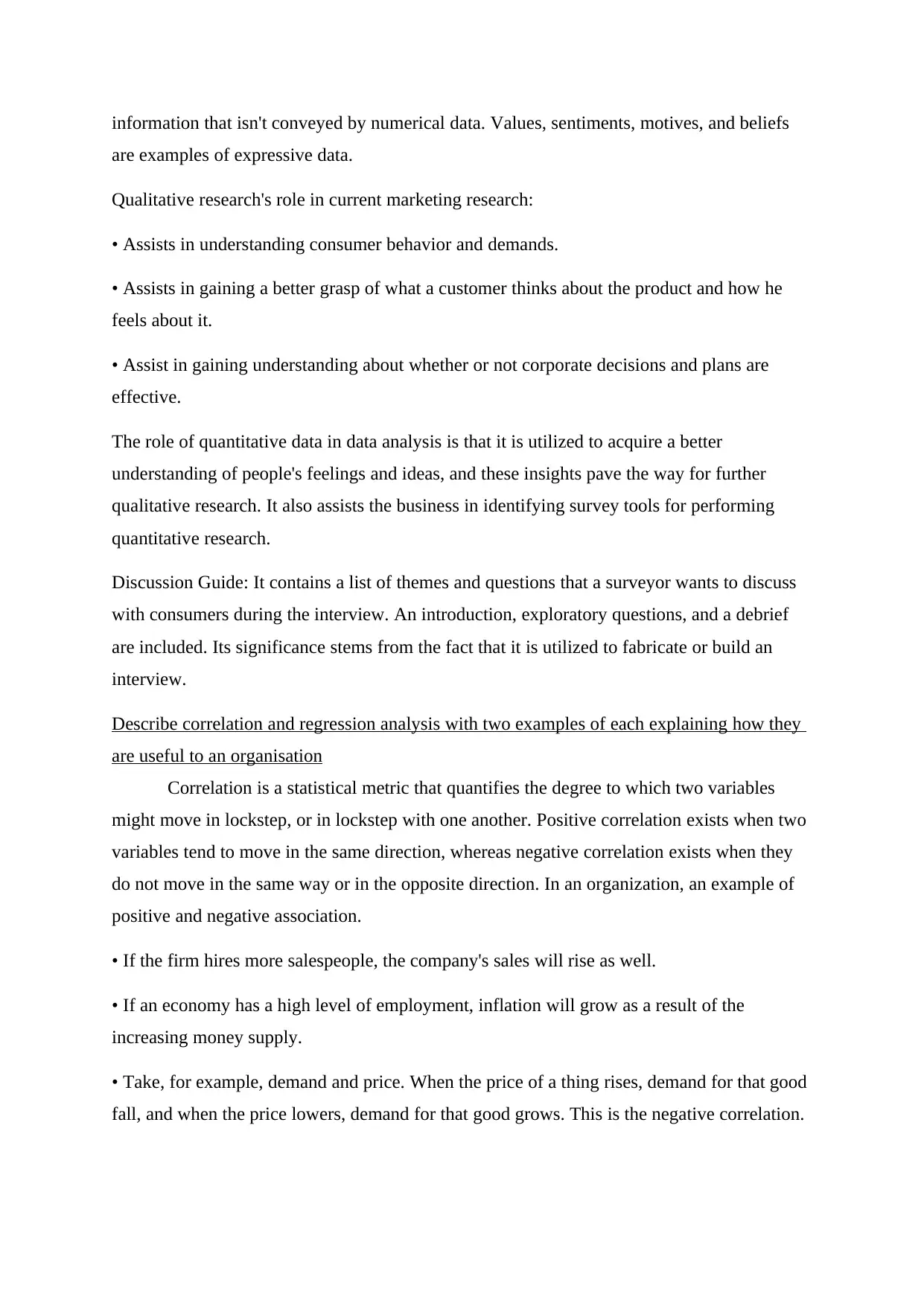
information that isn't conveyed by numerical data. Values, sentiments, motives, and beliefs
are examples of expressive data.
Qualitative research's role in current marketing research:
• Assists in understanding consumer behavior and demands.
• Assists in gaining a better grasp of what a customer thinks about the product and how he
feels about it.
• Assist in gaining understanding about whether or not corporate decisions and plans are
effective.
The role of quantitative data in data analysis is that it is utilized to acquire a better
understanding of people's feelings and ideas, and these insights pave the way for further
qualitative research. It also assists the business in identifying survey tools for performing
quantitative research.
Discussion Guide: It contains a list of themes and questions that a surveyor wants to discuss
with consumers during the interview. An introduction, exploratory questions, and a debrief
are included. Its significance stems from the fact that it is utilized to fabricate or build an
interview.
Describe correlation and regression analysis with two examples of each explaining how they
are useful to an organisation
Correlation is a statistical metric that quantifies the degree to which two variables
might move in lockstep, or in lockstep with one another. Positive correlation exists when two
variables tend to move in the same direction, whereas negative correlation exists when they
do not move in the same way or in the opposite direction. In an organization, an example of
positive and negative association.
• If the firm hires more salespeople, the company's sales will rise as well.
• If an economy has a high level of employment, inflation will grow as a result of the
increasing money supply.
• Take, for example, demand and price. When the price of a thing rises, demand for that good
fall, and when the price lowers, demand for that good grows. This is the negative correlation.
are examples of expressive data.
Qualitative research's role in current marketing research:
• Assists in understanding consumer behavior and demands.
• Assists in gaining a better grasp of what a customer thinks about the product and how he
feels about it.
• Assist in gaining understanding about whether or not corporate decisions and plans are
effective.
The role of quantitative data in data analysis is that it is utilized to acquire a better
understanding of people's feelings and ideas, and these insights pave the way for further
qualitative research. It also assists the business in identifying survey tools for performing
quantitative research.
Discussion Guide: It contains a list of themes and questions that a surveyor wants to discuss
with consumers during the interview. An introduction, exploratory questions, and a debrief
are included. Its significance stems from the fact that it is utilized to fabricate or build an
interview.
Describe correlation and regression analysis with two examples of each explaining how they
are useful to an organisation
Correlation is a statistical metric that quantifies the degree to which two variables
might move in lockstep, or in lockstep with one another. Positive correlation exists when two
variables tend to move in the same direction, whereas negative correlation exists when they
do not move in the same way or in the opposite direction. In an organization, an example of
positive and negative association.
• If the firm hires more salespeople, the company's sales will rise as well.
• If an economy has a high level of employment, inflation will grow as a result of the
increasing money supply.
• Take, for example, demand and price. When the price of a thing rises, demand for that good
fall, and when the price lowers, demand for that good grows. This is the negative correlation.

Regression analysis is a precise method for determining which factors impact a certain issue.
It aids the company in determining the most important components and parts, as well as
which factors might be overlooked and how they interact.
• For example, a business can project the number of people who will buy a product and use
this information to determine the amount of manpower, workforce, and resources required to
produce the product.
• Insurance companies, for example, use regression analysis to compute policyholder credit
health and the potential amount of claims in a given time period.
Define time series and explain how it is used in an organization.
A time series is a set of observations of well-defined data items gathered over time by
numerous tests. Time series is used to assess a model that may be utilized to predict business
tools like stock prices, sales, turnover, profit, and so on. It's utilized in retail demand
forecasting, procurement, and dynamic pricing in an organization: Making customer demand
estimates is critical since item procurement and supply are totally dependent on this factor.
Time series aid in the analysis and interpretation of the past, which is important in making
future forecasts or presumptions (Zhu, Fritzler, and Orlowski.,2018). This is extremely
beneficial to the organization because the projection is based on a historical pattern of data
points gathered over a period of time. The company can make comparisons between current
and previous patterns.
Importance of correlation and regression in the business organization.
Correlation is a term defined as the relationship between data in a business, most commonly
used in financial reporting analysis, which supports business decision-making. The regression
term used defines the relationship between the data recorded in the collection and is also used
to define that if one dataset changes, it will further lead to corresponding changes in the other
dataset. (Chetty., 2021)
Regression is a common tool used in data analysis for forecasting, product and service
development, and predicting future market trends. Correlation and regression analysis can
help business leaders make more impactful predictions based on patterns of data (Noor,
Cherkaoui and Sauer., 2019). This process can help to guide business processes, direction,
and performance in a way that will improve management, better customer experience
strategies, and optimized operations.
It aids the company in determining the most important components and parts, as well as
which factors might be overlooked and how they interact.
• For example, a business can project the number of people who will buy a product and use
this information to determine the amount of manpower, workforce, and resources required to
produce the product.
• Insurance companies, for example, use regression analysis to compute policyholder credit
health and the potential amount of claims in a given time period.
Define time series and explain how it is used in an organization.
A time series is a set of observations of well-defined data items gathered over time by
numerous tests. Time series is used to assess a model that may be utilized to predict business
tools like stock prices, sales, turnover, profit, and so on. It's utilized in retail demand
forecasting, procurement, and dynamic pricing in an organization: Making customer demand
estimates is critical since item procurement and supply are totally dependent on this factor.
Time series aid in the analysis and interpretation of the past, which is important in making
future forecasts or presumptions (Zhu, Fritzler, and Orlowski.,2018). This is extremely
beneficial to the organization because the projection is based on a historical pattern of data
points gathered over a period of time. The company can make comparisons between current
and previous patterns.
Importance of correlation and regression in the business organization.
Correlation is a term defined as the relationship between data in a business, most commonly
used in financial reporting analysis, which supports business decision-making. The regression
term used defines the relationship between the data recorded in the collection and is also used
to define that if one dataset changes, it will further lead to corresponding changes in the other
dataset. (Chetty., 2021)
Regression is a common tool used in data analysis for forecasting, product and service
development, and predicting future market trends. Correlation and regression analysis can
help business leaders make more impactful predictions based on patterns of data (Noor,
Cherkaoui and Sauer., 2019). This process can help to guide business processes, direction,
and performance in a way that will improve management, better customer experience
strategies, and optimized operations.
⊘ This is a preview!⊘
Do you want full access?
Subscribe today to unlock all pages.

Trusted by 1+ million students worldwide
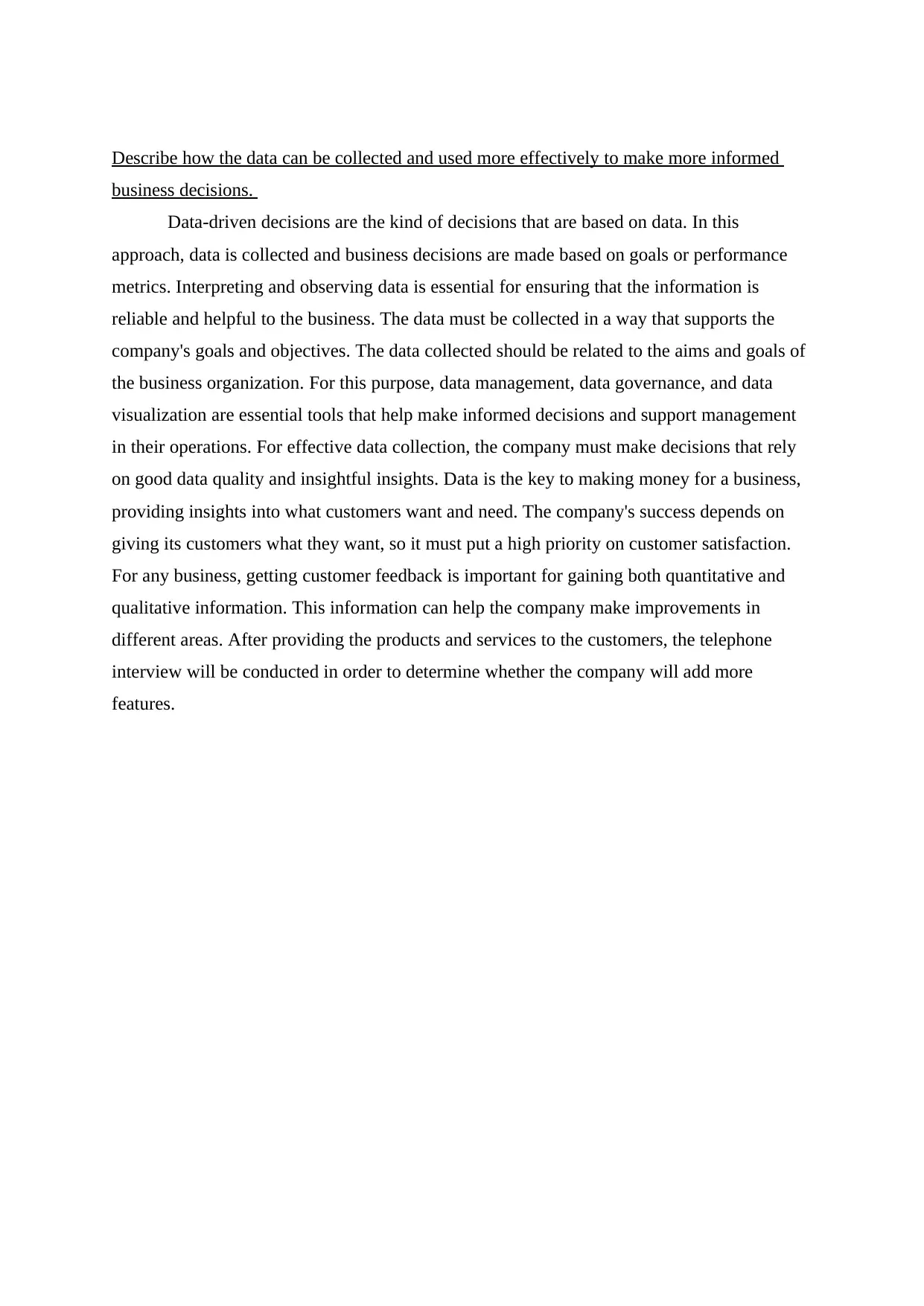
Describe how the data can be collected and used more effectively to make more informed
business decisions.
Data-driven decisions are the kind of decisions that are based on data. In this
approach, data is collected and business decisions are made based on goals or performance
metrics. Interpreting and observing data is essential for ensuring that the information is
reliable and helpful to the business. The data must be collected in a way that supports the
company's goals and objectives. The data collected should be related to the aims and goals of
the business organization. For this purpose, data management, data governance, and data
visualization are essential tools that help make informed decisions and support management
in their operations. For effective data collection, the company must make decisions that rely
on good data quality and insightful insights. Data is the key to making money for a business,
providing insights into what customers want and need. The company's success depends on
giving its customers what they want, so it must put a high priority on customer satisfaction.
For any business, getting customer feedback is important for gaining both quantitative and
qualitative information. This information can help the company make improvements in
different areas. After providing the products and services to the customers, the telephone
interview will be conducted in order to determine whether the company will add more
features.
business decisions.
Data-driven decisions are the kind of decisions that are based on data. In this
approach, data is collected and business decisions are made based on goals or performance
metrics. Interpreting and observing data is essential for ensuring that the information is
reliable and helpful to the business. The data must be collected in a way that supports the
company's goals and objectives. The data collected should be related to the aims and goals of
the business organization. For this purpose, data management, data governance, and data
visualization are essential tools that help make informed decisions and support management
in their operations. For effective data collection, the company must make decisions that rely
on good data quality and insightful insights. Data is the key to making money for a business,
providing insights into what customers want and need. The company's success depends on
giving its customers what they want, so it must put a high priority on customer satisfaction.
For any business, getting customer feedback is important for gaining both quantitative and
qualitative information. This information can help the company make improvements in
different areas. After providing the products and services to the customers, the telephone
interview will be conducted in order to determine whether the company will add more
features.
Paraphrase This Document
Need a fresh take? Get an instant paraphrase of this document with our AI Paraphraser

CONCLUSION
From the above it can be concluded that the quantitative and qualitative research is
essential in understanding the terms of figures and emotions in a business. It is clear that the
questionnaire and telephone interviews can help business organizations make informed
decisions based on data. Moreover, the discussion guide can help structure the interview and
have a significant impact on the company.
From the above it can be concluded that the quantitative and qualitative research is
essential in understanding the terms of figures and emotions in a business. It is clear that the
questionnaire and telephone interviews can help business organizations make informed
decisions based on data. Moreover, the discussion guide can help structure the interview and
have a significant impact on the company.
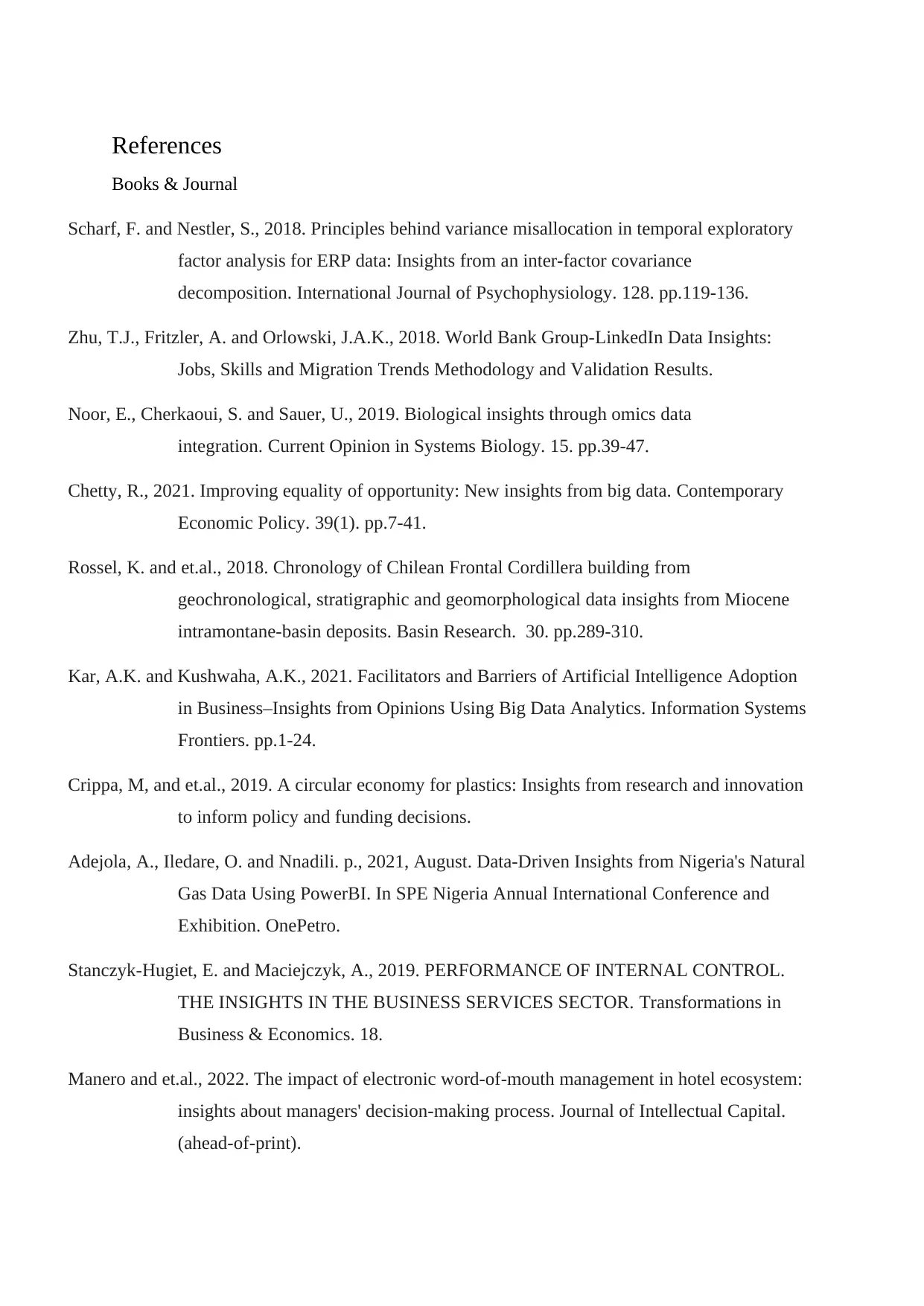
References
Books & Journal
Scharf, F. and Nestler, S., 2018. Principles behind variance misallocation in temporal exploratory
factor analysis for ERP data: Insights from an inter-factor covariance
decomposition. International Journal of Psychophysiology. 128. pp.119-136.
Zhu, T.J., Fritzler, A. and Orlowski, J.A.K., 2018. World Bank Group-LinkedIn Data Insights:
Jobs, Skills and Migration Trends Methodology and Validation Results.
Noor, E., Cherkaoui, S. and Sauer, U., 2019. Biological insights through omics data
integration. Current Opinion in Systems Biology. 15. pp.39-47.
Chetty, R., 2021. Improving equality of opportunity: New insights from big data. Contemporary
Economic Policy. 39(1). pp.7-41.
Rossel, K. and et.al., 2018. Chronology of Chilean Frontal Cordillera building from
geochronological, stratigraphic and geomorphological data insights from Miocene
intramontane‐basin deposits. Basin Research. 30. pp.289-310.
Kar, A.K. and Kushwaha, A.K., 2021. Facilitators and Barriers of Artificial Intelligence Adoption
in Business–Insights from Opinions Using Big Data Analytics. Information Systems
Frontiers. pp.1-24.
Crippa, M, and et.al., 2019. A circular economy for plastics: Insights from research and innovation
to inform policy and funding decisions.
Adejola, A., Iledare, O. and Nnadili. p., 2021, August. Data-Driven Insights from Nigeria's Natural
Gas Data Using PowerBI. In SPE Nigeria Annual International Conference and
Exhibition. OnePetro.
Stanczyk-Hugiet, E. and Maciejczyk, A., 2019. PERFORMANCE OF INTERNAL CONTROL.
THE INSIGHTS IN THE BUSINESS SERVICES SECTOR. Transformations in
Business & Economics. 18.
Manero and et.al., 2022. The impact of electronic word-of-mouth management in hotel ecosystem:
insights about managers' decision-making process. Journal of Intellectual Capital.
(ahead-of-print).
Books & Journal
Scharf, F. and Nestler, S., 2018. Principles behind variance misallocation in temporal exploratory
factor analysis for ERP data: Insights from an inter-factor covariance
decomposition. International Journal of Psychophysiology. 128. pp.119-136.
Zhu, T.J., Fritzler, A. and Orlowski, J.A.K., 2018. World Bank Group-LinkedIn Data Insights:
Jobs, Skills and Migration Trends Methodology and Validation Results.
Noor, E., Cherkaoui, S. and Sauer, U., 2019. Biological insights through omics data
integration. Current Opinion in Systems Biology. 15. pp.39-47.
Chetty, R., 2021. Improving equality of opportunity: New insights from big data. Contemporary
Economic Policy. 39(1). pp.7-41.
Rossel, K. and et.al., 2018. Chronology of Chilean Frontal Cordillera building from
geochronological, stratigraphic and geomorphological data insights from Miocene
intramontane‐basin deposits. Basin Research. 30. pp.289-310.
Kar, A.K. and Kushwaha, A.K., 2021. Facilitators and Barriers of Artificial Intelligence Adoption
in Business–Insights from Opinions Using Big Data Analytics. Information Systems
Frontiers. pp.1-24.
Crippa, M, and et.al., 2019. A circular economy for plastics: Insights from research and innovation
to inform policy and funding decisions.
Adejola, A., Iledare, O. and Nnadili. p., 2021, August. Data-Driven Insights from Nigeria's Natural
Gas Data Using PowerBI. In SPE Nigeria Annual International Conference and
Exhibition. OnePetro.
Stanczyk-Hugiet, E. and Maciejczyk, A., 2019. PERFORMANCE OF INTERNAL CONTROL.
THE INSIGHTS IN THE BUSINESS SERVICES SECTOR. Transformations in
Business & Economics. 18.
Manero and et.al., 2022. The impact of electronic word-of-mouth management in hotel ecosystem:
insights about managers' decision-making process. Journal of Intellectual Capital.
(ahead-of-print).
⊘ This is a preview!⊘
Do you want full access?
Subscribe today to unlock all pages.

Trusted by 1+ million students worldwide

1 out of 10
Related Documents
Your All-in-One AI-Powered Toolkit for Academic Success.
+13062052269
info@desklib.com
Available 24*7 on WhatsApp / Email
![[object Object]](/_next/static/media/star-bottom.7253800d.svg)
Unlock your academic potential
Copyright © 2020–2025 A2Z Services. All Rights Reserved. Developed and managed by ZUCOL.
